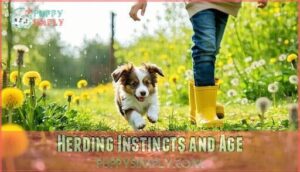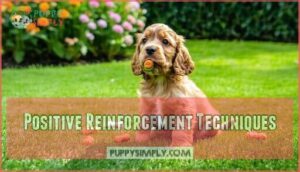This site is supported by our readers. We may earn a commission, at no cost to you, if you purchase through links.

Shelties naturally go through peak nipping around 12-16 weeks due to their herding instincts, but consistent training during this window makes all the difference. Some adolescent Shelties may need firmer boundaries if early training wasn’t consistent, but proper techniques combined with natural development usually resolve the issue by their first birthday.
Table Of Contents
- Key Takeaways
- When Do Sheltie Puppies Stop Biting?
- Why Do Shelties Bite and Nip?
- How to Teach Bite Inhibition in Shelties
- Redirecting Biting With Chew Toys and Rewards
- Preventing Persistent Nipping in Adolescent Shelties
- Frequently Asked Questions (FAQs)
- How long does it typically take for Shelties to stop biting?
- What are some signs that biting in Shelties may be excessive or problematic?
- Can adult Shelties suddenly start biting again?
- Do male or female Shelties bite more?
- What foods reduce puppy biting behavior?
- Should I muzzle my biting Sheltie puppy?
- Can anxiety medication help aggressive Sheltie biting?
- Conclusion
Key Takeaways
- Your Sheltie will naturally stop their intense biting phase between 4-6 months when teething ends, but you’ll need consistent training during the 8-16 week peak period to ensure success.
- You can teach bite inhibition by saying "ouch" firmly when teeth touch skin, then stopping all interaction for 30 seconds—this shows your pup that gentle mouths get rewarded while hard bites end the fun.
- You’ll need to redirect their herding-driven nipping to appropriate chew toys and never reward rough play with attention, as Shelties’ natural instincts make them want to "manage" your movements.
- If you don’t address biting consistently during puppyhood, some adolescent Shelties may continue nipping past 6 months, requiring firmer boundaries and professional training classes to correct the behavior.
When Do Sheltie Puppies Stop Biting?
You’ll be relieved to know that most Sheltie puppies naturally stop their intense biting between 4 and 6 months old as they finish teething and mature.
However, some herding-related nipping can continue into adolescence if you don’t address it with consistent training early on.
Typical Puppy Biting Timeline
Most Sheltie puppies show frequent biting between 8-16 weeks during normal exploration. This puppy behavior peaks during teething (12-24 weeks) as discomfort drives increased mouthing. You’ll notice significant improvement by 5-6 months when the teething duration ends.
Training milestones matter—puppies lacking early socialization may continue biting past six months without consistent guidance. Early training can help establish bite inhibition training.
Effects of Teething and Maturation
During the teething timeline, your Sheltie puppy’s bite intensity peaks around 3-4 months when permanent teeth emerge. This uncomfortable process drives increased puppy biting as they seek relief.
Maturity impact becomes evident by 4-6 months when most Shelties naturally reduce mouthiness. Early separation from littermates can cause lingering mouthiness into adolescence.
Consistent bite inhibition training during this vital window ensures training success with your developing Sheltie puppy. Owners can also utilize positive reinforcement techniques to discourage unwanted biting.
Herding Instincts and Age
Around 12-16 weeks, herding intensity peaks in your Sheltie puppy as instinct development accelerates. Early separation from littermates before seven weeks often intensifies nipping and play biting behaviors. Age thresholds matter—bite inhibition training between 8-12 weeks yields the best results.
Key training impact factors:
- Consistent redirection during peak herding phases
- Teaching bite inhibition through structured play sessions
- Managing excitement levels to prevent instinct-driven nipping
Why Do Shelties Bite and Nip?
You’ll notice your Sheltie’s biting and nipping stems from three main causes that every owner faces.
Your pup uses their mouth to explore the world, express herding instincts, and communicate excitement or fear.
Herding and Play Behavior
Their herding instincts turn everyday play into a "job interview" for your ankles. Sheltie Puppy Biting Behavior stems from breed tendencies where nipping and play biting feels natural.
For Shelties, everyday play becomes a job interview for your ankles as their herding instincts turn natural nipping into purposeful behavior
These Play Styles involve quick heel-nips during rough play. Early Socialization Impact helps, but Boundary Setting remains essential.
Teaching bite inhibition redirects their focus from managing you to appropriate toys.
Exploration and Curiosity
Your puppy’s mouth becomes their primary tool for discovering the world around them. Just like toddlers grab everything, Sheltie puppies use mouthy exploration to gather sensory input about textures, tastes, and temperatures.
This environmental interaction fosters their cognitive development as they learn what’s safe, interesting, or fun. Breed differences in curiosity levels mean some Sheltie puppy biting behavior stems purely from this natural learning process.
Overexcitement and Fear Responses
When your Sheltie puppy gets overwhelmed or scared, fear-induced biting often follows. Overcoming fear requires recognizing your pup’s excitement thresholds before they hit panic mode.
Create safe spaces where your Sheltie puppy can retreat when anxious. Use calming techniques like gentle voices and slow movements.
Proper anxiety management prevents fear from escalating into biting episodes during stressful situations. Early intervention can help prevent possessive aggression from becoming a long-term problem.
How to Teach Bite Inhibition in Shelties
Teaching your Sheltie bite inhibition isn’t as tricky as it sounds, and you’ll see results faster than you might expect.
You’ll use simple vocal cues like "ouch" and brief time-outs to show your pup that gentle play gets rewarded while hard bites end the fun immediately.
Bite Inhibition Training Steps
Teaching bite inhibition to your Sheltie puppy starts with understanding bite pressure control. When your pup bites too hard, immediately say "ouch" and stop play. Redirect to appropriate chew toys while maintaining reward consistency for gentle mouthing.
Early socialization helps puppies learn acceptable bite pressure through peer feedback. Practice these steps daily—consistent timing with vocal cues teaches your Sheltie puppy proper boundaries around puppy biting behavior.
It’s vital to teach them bite inhibition early because its development begins to close at four-and-a-half months of age.
Using Vocal Cues and Time-outs
When your pup crosses into nipping territory, vocal cues and time-outs work like magic. A sharp "ouch" or yelp mimics littermate feedback, teaching bite inhibition naturally. Follow with a brief timeout—30 seconds works perfectly for puppy biting episodes. There are many resources for effective vocal cue training.
- Use high-pitched vocal cue timing immediately when teeth touch skin
- Keep time-out duration short (30-60 seconds) to avoid confusion
- Maintain calm handling throughout the aggression threshold moment
- Apply consistency matters principle—same response every single time
- Resume play only after your pup settles completely
Importance of Consistent Responses
Consistency becomes your strongest ally when teaching bite inhibition to your Sheltie puppy. Everyone in your household must respond identically to puppy biting incidents. Mixed messages confuse your pup and slow progress substantially.
| Consistent Approach | Inconsistent Approach |
|---|---|
| Everyone says "ouch" and stops play | Some ignore, others yell |
| Same time-out duration used | Varying consequences applied |
| All family members redirect to toys | Only one person trains |
| Clear expectations maintained daily | Rules change based on mood |
| Reward positive behavior immediately | Delayed or forgotten rewards |
Training consistency and clear expectations prevent confusion while reinforcement schedules help your Sheltie puppy understand boundaries.
Redirecting Biting With Chew Toys and Rewards
You’ll transform your Sheltie’s biting into appropriate chewing by offering the right alternatives at the right moments.
When your pup grabs your hand or clothing, immediately redirect them to a sturdy chew toy and reward them with praise or treats when they choose the toy instead.
Positive Reinforcement Techniques
Success thrives on perfect reward timing with your Sheltie puppy. Reward positive behavior within seconds of good choices to strengthen positive interaction. Choose high-value treats your pup craves—small, soft pieces work best.
Clicker training accelerates shaping behavior by marking exact moments of success. Consistency matters more than precision. When your Sheltie puppy chooses a toy over nipping and play biting, immediately reward that choice. This creates clear communication about what earns your praise and treats.
This method aligns with operant conditioning principles.
Removing Rewards for Unwanted Behavior
When your Sheltie puppy bites or engages in nipping, removing their reward immediately works wonders. Stop play, turn away, and ignore bad behavior completely. This reward withdrawal timing teaches them that play biting ends the fun. Don’t give attention during these moments—even negative reactions can reinforce the behavior.
Instead, wait for calm behavior before offering alternative reinforcements like praise or treats. Some owners find success with appropriate chew products to redirect this behavior.
Consistency importance can’t be overstated here. Every family member must follow the same approach, avoiding escalation through mixed messages.
Preventing Persistent Nipping in Adolescent Shelties
If your adolescent Sheltie still nips despite your earlier training efforts, don’t worry—this stubborn phase is completely normal and fixable with the right approach.
You’ll need to step up your consistency game and establish firmer boundaries that make it crystal clear when playtime crosses the line.
Setting and Enforcing Boundaries
Beyond chew toy redirection, you’ll need consistent limits to curb persistent nipping. When your Sheltie crosses boundaries, use the cold shoulder technique—turn away and avoid eye contact. This social isolation teaches that bad behavior ends fun interactions.
Never avoid punishment through yelling; instead, implement brief time outs. Early separation from littermates often worsens biting, so teach bite inhibition patiently through training.
Enrolling in Puppy Training Classes or Online Courses
Professional dog training classes offer structured class socialization and expert guidance your Sheltie puppy needs. Online dog training courses provide convenient behavioral insights from home.
- Expert trainers spot herding-specific nipping patterns you might miss
- Class socialization teaches your puppy appropriate play with other dogs
- Online convenience lets you practice techniques on your schedule
- Cost comparison often favors group classes over private sessions
- Behavioral insights help address underlying causes of persistent nipping
Puppy training classes accelerate your progress substantially. You can begin with basic obedience training as early as eight weeks.
Managing Play and Avoiding Rough Games
Many Sheltie owners discover that rough play triggers intense nipping and play biting episodes. You’ll want to establish gentle playtime with appropriate toys instead of wrestling or chase games.
Recognizing limits means watching for overexcitement signals before your Sheltie puppy escalates. Calm interactions work better than high-energy activities. Avoiding triggers like sudden movements prevents unnecessary play biting behaviors.
Frequently Asked Questions (FAQs)
How long does it typically take for Shelties to stop biting?
Like watching a wild river gradually calm into a peaceful stream, your Sheltie’s biting journey unfolds naturally. Most Shelties stop biting between four and six months as teething ends and maturity kicks in.
What are some signs that biting in Shelties may be excessive or problematic?
Watch for biting that draws blood, continues past six months, happens during calm moments, or escalates with growling. You’ll also notice problematic patterns when redirection fails consistently.
Can adult Shelties suddenly start biting again?
Your once-gentle companion’s sudden snapping catches you off guard, but yes, adult Shelties can resume biting due to stress, illness, fear, or major life changes.
You’ll need to identify triggers and retrain using consistent positive methods.
Do male or female Shelties bite more?
Research suggests male dogs generally bite more than females, but it’s unknown if male Shetland Sheepdogs follow this pattern. Individual personality matters more than gender for Shelties’ biting behavior.
What foods reduce puppy biting behavior?
Forget the promise of a magic pill that’ll transform your nippy pup overnight. Foods with L-tryptophan, chamomile, and ashwagandha can promote relaxation, but you’ll need consistency and training to truly curb biting behavior effectively.
Should I muzzle my biting Sheltie puppy?
Don’t muzzle your biting Sheltie puppy. Muzzles prevent natural mouth exploration and can increase anxiety.
Instead, redirect biting to toys, use positive training methods, and practice bite inhibition techniques for better results.
Can anxiety medication help aggressive Sheltie biting?
Anxiety medication can help with fear-based biting in Shelties, but no drug will prevent biting. It works alongside training—not as a standalone solution. Consult your vet first.
Conclusion
Consider Sarah’s 14-week-old Sheltie who went from gentle puppy play to persistent ankle-nipping within days. Understanding when Shelties (Shetland Sheepdogs) stop biting and how to stop it makes all the difference in your training success.
Most Shelties naturally outgrow their intense biting phase by 6 months, but your consistent training during those vital early weeks determines how smoothly this progression happens. Stay patient, stick to your bite inhibition techniques, and remember that every "ouch" and redirect you provide today builds the foundation for a well-mannered adult dog tomorrow.
- https://www.dogforum.com/threads/new-sheltie-puppy-correct-schedule-and-expectations.377531/
- https://iheartdogs.com/whats-the-bite-force-of-a-sheltie-does-it-hurt/
- https://sheltieforums.com/threads/hyper-and-bites.1630/
- https://www.sheltieplanet.com/nipping-and-play-biting
- https://yourpetandyou.elanco.com/us/behavior/5-steps-to-stop-your-puppy-from-biting-and-nipping














